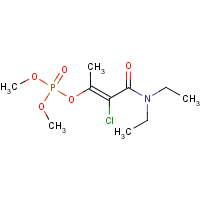Phosphamidon
Agent Name
Phosphamidon
CAS Number
13171-21-6
Formula
C10-H19-Cl-N-O5-P
Major Category
Pesticides

Synonyms
(2-Chloor-3-diethylamino-1-methyl-3-oxo-prop-1-en-yl)-dimethyl-fosfaat [Dutch]; (2-Chlor-3-diaethylamino-1-methyl-3-oxo-prop-1-en-yl)-dimethyl-phosphat [German]; (2-Cloro-3-dietilamino-1-metil-3-oxo-prop-1-en-il)-dimetil-fosfato [Italian]; (O,O-Dimethyl-O-(1-methyl-2-chloro-2-diethylcarbamoyl-vinyl) phosphate); 1-Chloro-diethylcarbamoyl-1-propen-2-yl dimethyl phosphate; 2-Chloro-2-diethylcarbamoyl-1-methylvinyl dimethylphosphate; 2-Chloro-2-diethylcarbamyl-1-methylvinyl-dimethyl phosphate; 2-Chloro-3-(diethylamino)-1-methyl-3-oxo-1-propenyl dimethyl phosphate; 2-Chloro-3-dimethoxyphosphinoyloxy-N,N-diethylbut-2-enamide; 2-Chloro-N,N-diethyl-3-hydroxycrotonamide dimethyl phosphate; 2-Chloro-N,N-diethyl-3-hydroxycrotonamide ester with dimethyl phosphate; Apamidon; C 570; Ciba 570; Crotonamide, 2-chloro-N,N-diethyl-3-hydroxy-, dimethyl phosphate; Dimecron; Dimecron 100; Dimethyl 2-chloro-2-diethylcarbamoyl-1-methylvinyl phosphate; Dimethyl diethylamido-1-chlorocrotonyl (2) phosphate; Dimethyl phosphate ester with 2-chloro-N,N-diethyl-3-hydroxycrotonamide (8CI); Dimethyl phosphate of 2-chloro-N,N-diethyl-3-hydroxycrotonamide; Dixon; ENT 25515; Famfos; Fosfamidon [Dutch]; Fosfamidone [Italian]; Foszfamidon (Hungarian); ML 97; Merkon; O,O-Dimethyl O-(2-chloro-2-(N,N-diethylcarbamoyl)-1-methylvinyl) phosphate; O,O-Dimethyl-O-(1-methyl-2-chlor-2-N,N-diaethyl-carbamoyl)-vinyl-phosphat [German]; OMS 1325; OR 1191; Phosphamidon 85 WSC; Phosphamidone; Phosphate de dimethyle et de (2-chloro-2-diethylcarbamoyl-1-methyl-vinyle) [French]; Sundaram 1975; Phosphoric acid, 2-chloro-3-(diethylamino)-1-methyl-3-oxo-1-propenyl dimethyl ester; [ChemIDplus] UN3018
Category
Organophosphate Insecticides
Description
Colorless to yellow liquid; [ICSC]
Sources/Uses
Used as systemic insecticide for deciduous fruits and nuts, cotton, rice, cereals, potatoes, soy beans, and other crops; [HSDB] Used as acaricide; [CAMEO]
Comments
An eye irritant; Can be absorbed through skin; A cholinesterase inhibitor that may cause CNS effects resulting in convulsions and respiratory depression; [ICSC] Gamma-Chlorophosphamidon, present as an impurity at a level of 1-2% in the technical product, is approximately 20 times more potent as a human cholinesterase inhibitor; In a human test involving unprotected exposure from aircraft spraying in a paddy field, volunteers experienced immediate eye irritation and depression of plasma cholinesterase by as much as 50%; No evidence of delayed neurotoxicity in hens; [HSDB] “The average of two baseline respective cholinesterase activity determinations three days apart, with no exposures to enzyme inhibiting pesticides for at least 30 days, is recommended for each worker prior to exposure to cholinesterase inhibitors because of large inter-individual differences in published baseline values. To be established at least once a year. Removal from workplace exposures is recommended until the cholinesterase activity returns to within 20% of baseline.” [TLVs and BEIs]
Restricted
Cancelled--no longer registered as a pesticide for use in the US; [HSDB] Banned in the EU for use as a biocide and agricultural insecticide; [eChemPortal: ESIS]
Biomedical References
Exposure Assessment
BEI
Acetylcholinesterase activity in red blood cells = 70% of individual's baseline; Butylcholinesterase activity in serum or plasma = 60% of individual's baseline; Sample at end of shift; [TLVs and BEIs]
Vapor Pressure
1.65E-05 mm Hg
Lethal Concentration
LC50 (rat) = 135 mg/m3/4h
Explanatory Notes
The Guide in the Emergency Response Guidebook is for "Organophosphorus pesticide, liquid, toxic."
Adverse Effects
Other Poison
Organophosphate
Diseases, Processes, and Activities Linked to This Agent
Diseases
Occupational diseases associated with exposure to this agent:
Processes
Industrial Processes with risk of exposure: